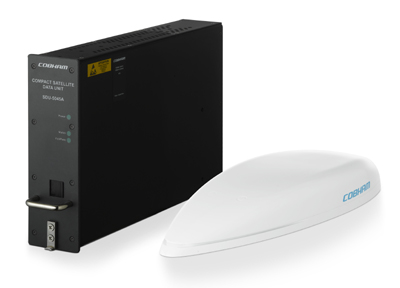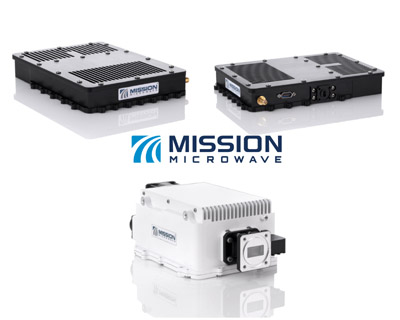I was suppose to fly down to DC on Tues to spend a couple of days catching up on the newest trends and products at Satellite 2018. But the Nor'easter dumped 2 feet of snow on Boston and every flight I could find was cancelled. So I remotely monitored the happenings at the event and collected the following materials from press releases and emails about what was on display for RF/microwave products:
AtlanTecRF launched the new Multi-Path Satellite Simulator System (the MSS Series). The MSS Systems are designed to ‘talk’ to two ground-based or mobile satcom stations, simultaneously, thereby replicating for test purposes, the satellite link while remaining off-air. Each system consists of three parts, a base control unit and two weatherproof transponders each of which can be orientated to connect with a system under test (SUT) antenna. There is also the option to incorporate all of the digital control within one transponder housing to achieve a two-part test system. The base control unit is a convenient portable bench instrument with the capability of both local and remote, Ethernet control. The two transponders are inter-connected - each capable of communicating with a fixed or mobile terminal in a choice of either X-, Ku-, DBS, Ka- and Q-bands and with the ability to vary the path attenuation, thereby reducing the real-world atmospheric effects.
 Cobham SATCOM was highlighting the engineering breakthroughs behind its most technologically advanced terminals, the next-gen Inmarsat Class 4 AVIATOR S series and AVIATOR UAV 200. To create the first Class 4 Inmarsat terminals, Cobham designed a simple to manufacture, radiating structure, which allowed spreading of excessive gain at boresight down to the lower elevations. Previously, the only low gain antennas on the market typically consisted of helix radiators, offering low gain from antenna boresight down to about 20 degrees above the horizon, which did not cover the full Inmarsat hemisphere down to 5 degrees above the horizon. For the advanced AVIATOR S system, Cobham developed the very compact HELGA (combined HLD and Enhanced LGA) antenna, which contains an ELGA antenna as well as a DLNA function and High Power Amplifier in one package. Other Cobham division included Aerospace Communications showing space-qualified Ku- and Ka- waveguides, and microwave components for satellites, test benches, and spaceborne positioning systems and datalink antennas and Advanced Electronic Solutions showing space-qualified waveguides, antennas, RF cables, rotary joints and other products for communications, electronic warfare, and other applications. Also, RadHard microelectronics for small or large satellites and high reliability motion control solutions for spacecraft were on display.
Cobham SATCOM was highlighting the engineering breakthroughs behind its most technologically advanced terminals, the next-gen Inmarsat Class 4 AVIATOR S series and AVIATOR UAV 200. To create the first Class 4 Inmarsat terminals, Cobham designed a simple to manufacture, radiating structure, which allowed spreading of excessive gain at boresight down to the lower elevations. Previously, the only low gain antennas on the market typically consisted of helix radiators, offering low gain from antenna boresight down to about 20 degrees above the horizon, which did not cover the full Inmarsat hemisphere down to 5 degrees above the horizon. For the advanced AVIATOR S system, Cobham developed the very compact HELGA (combined HLD and Enhanced LGA) antenna, which contains an ELGA antenna as well as a DLNA function and High Power Amplifier in one package. Other Cobham division included Aerospace Communications showing space-qualified Ku- and Ka- waveguides, and microwave components for satellites, test benches, and spaceborne positioning systems and datalink antennas and Advanced Electronic Solutions showing space-qualified waveguides, antennas, RF cables, rotary joints and other products for communications, electronic warfare, and other applications. Also, RadHard microelectronics for small or large satellites and high reliability motion control solutions for spacecraft were on display.
 The Satcom Products Group of Communications & Power Industries’ Satcom & Medical Products Division was displaying a big lineup of high-power uplink amplifiers including:
The Satcom Products Group of Communications & Power Industries’ Satcom & Medical Products Division was displaying a big lineup of high-power uplink amplifiers including:
- CPI is rolling out OpenBMIP™ for iDirect modems in most of its Ka-band BUCs, starting with its airborne KRFUs. CPI’s in-flight connectivity (IFC) capabilities include flight-qualified Ku- and Ka-band GaN-powered BUCs and transceivers.
- CPI is continuing to develop V-band products on multiple platforms, including a 250 W TWTA. Current offerings include a 130 W TWTA, as well as more powerful klystrons at V-band and Q-band that operate at output power levels of up to 500 W.
- Now, users of klystron power amplifiers can benefit from CPI’s TouchPower™ technology, which was previously only provided on 5-RU TWTAs. This interface simplifies the setting and monitoring of desired parameters. The new GEN IV also boasts SNMP interface capability; a new RF power meter providing direct average power readings, and enhanced event log capability.
- Customers interested in acoustically quiet earth stations, longer TWT life and higher thermal margin may benefit from liquid cooling their HPAs.
- Where once troposcatter communications were typically the domain of S-band or low C-band, high Ku-band is also proving to be viable for secure troposcatter communications. CPI offers a high-power TWTA to meet this need.
- CPI is introducing a line of X-band GaN BUCs at 50 and 100 W, and continues to expand its line of state-of-the-art, light and compact transceivers featuring integrated orthomode transducers.
Kymeta announced that the company’s KyWay™ satellite terminals are now certified with the world’s leading satellite operators, including Intelsat, Telesat, SES, and HISPASAT. Antenna certification with these providers means that KyWay terminals successfully connect with the operator’s satellite spacecraft and do not cause adjacent satellite interference. Kymeta’s satellite terminals operate across a broad range of satellites, and can switch from satellite to satellite, automatically acquiring signals, no matter what operator owns them. The proven ability to establish a link without interference means an entire host of use cases are now possible for fixed and mobile satellite communications.
Quintech announced their XTREME 32 matrix switch has an innovative asymmetric design to offer either a 16x16 or 8x24 port fan-out configuration in a 1 RU chassis. The XTREME 32 features extended frequency range, low noise figure and high flatness RF performance. Standard independent input and output variable gains allow the user to balance input signals and provide optimum signal performance to the receivers. The RF inputs can be configured with 13/18V and 22 kHz tone LNB power that can be added while deployed in the field. The high-density matrix includes hot swappable and redundant power supplies. The XTREME 32 is available as either fan-out (splitting) or fan-in (combining) for downlink and uplink applications. They also announced that several Canadian wireless service and equipment providers successfully adopted Quintech NEXUS matrix switches for automating base station, antenna, and user equipment interoperability and certification tests in their laboratories. Quintech’s NEXUS line of test matrix switches passes LTE and WiFi signals with a frequency range between 600 to 6000 MHz. The NEXUS matrix switches are used in the interoperability and certification test labs, e.g. to certify burst network speeds in carrier aggregation configurations, to test successful handoff of calls and data between cell towers and to test and debug firmware and applications over new and legacy network configurations.
Rohde & Schwarz is entering the market for satellite uplink amplifiers in the Ku-Band with the R&S PKU100 that combines the best of two worlds in a single device: the strengths of solid-state amplifiers and the compactness and low weight of tube amplifiers. Adaptive linearization distinguishes the R&S PKU100 from other products. It comes in 400 and 750 W versions, each with a frequency range from 12.75 to 13.25 GHz and 13.75 o 14.5 GHz, covering the Ku-Band. The R&S PKU100 can be fitted with a block upconverter (BUC), allowing low-frequency L-band signals to be processed and converted to the Ku-Band. The amplifier can be controlled remotely; it supports all common standards such as a web interface, SNMP, RS-232 and parallel I/O interfaces.
SatixFy UK introduced its full Electronic Steered Multi-Beam Array antennas (ESMA). The scalable architecture supports any antenna size up to 1 million elements (in Ku-band 10 by 10 m), any frequency through a dedicated RFIC, any polarization including circular and linear simultaneously, any shape including conformal arrays and up to 32 beams both in receive and transmit. The antenna, based on a fully digital beam forming technology, supports an instantaneous bandwidth of over 1 GHz and works in both TDD and FDD modes. Expected array efficiency is better than 70%. The antenna includes an Antenna Control Unit, self-calibration capabilities, and on-chip trigonometric calculator for fast tracking and beam steering. The antenna supports any external modem through L-band interface but is best utilized when closely coupled with SatixFy’s current 500 MHz baseband modem chips (Sx3000).
Smiths Interconnect was displaying a range of technically differentiated connectivity solutions from its technology brands EMC Technology, Hypertac, IDI, Millitech, RF Labs, Sabritec, TECOM, and Trak Microwave including innovative antennas and tracking systems, integrated transceiver solutions, RF components, connectors and cable assemblies for the commercial and defense, aerospace and satellite communication markets. Some of the SATCOM connectivity oriented products on display included high performance, ferrite-based surface mount, strip line, and waveguide components, low loss 40 GHz cable assemblies, ruggedized D-sub connectors, attenuators, multiway combiners, coaxial terminators and loads, Ku- and Ka-band antenna systems, and an E-band tracking antenna. The new SpaceNXTTM HC Series high reliability temperature variable and fixed chip attenuators for next generation commercial space applications will be released as part of an overarching initiative that entails the creation of higher reliability products for mission-critical environments.
Soutwest Microwave was highlighting their 1.85mm, DC to 67 GHz PCB compression mount connector. It has the following features: 67 GHz of BW, optimal quality for SI, works with microstrip or GCPW, no soldering required, and is reusable. Launch design assistance is available from the company.
 Mission Microwave Technologies announced general availability of new very compact BUCs in Ku- and Ka-Bands for use in lightweight and embedded platforms. Mission Microwave’s Flatpack BUC, available in 12 W Ka-Band and 25 W Ku-Band versions, is highly integrated with a very low profile. The Flatpacks are only 1” thick and weigh only 1.75 lbs. They are completely self-contained with forced air cooling, a full Monitor and Control Interface, and suitable for rugged environments with an IP-67 rating. The Ku-Band Cube is a ruggedized 2.5 lb, 25 W BUC with a full suite of Monitor and Control functions available in serial or Ethernet formats. It is extremely efficient – drawing less than 80 Watts of DC power to produce 16 Watts of linear power.
Mission Microwave Technologies announced general availability of new very compact BUCs in Ku- and Ka-Bands for use in lightweight and embedded platforms. Mission Microwave’s Flatpack BUC, available in 12 W Ka-Band and 25 W Ku-Band versions, is highly integrated with a very low profile. The Flatpacks are only 1” thick and weigh only 1.75 lbs. They are completely self-contained with forced air cooling, a full Monitor and Control Interface, and suitable for rugged environments with an IP-67 rating. The Ku-Band Cube is a ruggedized 2.5 lb, 25 W BUC with a full suite of Monitor and Control functions available in serial or Ethernet formats. It is extremely efficient – drawing less than 80 Watts of DC power to produce 16 Watts of linear power.
Wavestream announced a new 60 W Ku-band GaN Block Upconverter. The new BUC maintains the same package size as the previous 40 W solution with the benefit of 40% more linear power while drawing 10% less DC power. The solution is intended for wide use in both commercial and military environments for Comm-On-The-Move and stationary VSAT applications.

